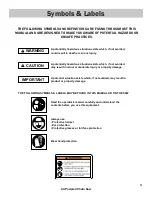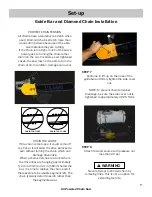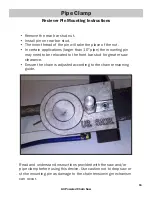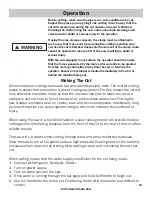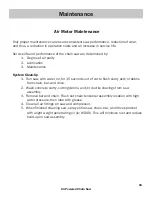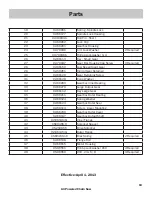
13
Operation
© 2010 ICS, Blount International Inc. Specifications are subject to change without notice. REV0611 F/N 545067
TITLE
695GC / 695F4 OPERATOR’S MANUAL
13
COLD ENGINE STARTING PROCEDURE
1. Pull the choke lever out, which also sets the throttle lock.
2. Depress primer bulb approximately 5-10 times.
3. Push in decompression valve.
4. Open the water valve 1/4 turn.
5. Place the saw on stable ground making sure the chain
is free of any obstructions.
6. Place foot on the base of the rear handle, and place one hand
on front handle.
7. With opposite hand, slowly pull starter handle until the
starter pawls engage.
8. Pull the starter cord (
hard, fast, short pulls
)
until engine initially fires or "pops"
.
Could be as many as 10-15 pulls.
9.
Push the choke lever in.
10. Pull the starter cord until engine starts - should be 1 to 2 pulls.
11. Release the throttle lock by momentarily squeezing on the
throttle trigger.
12. When the engine starts, allow the engine to idle briefly.
Squeeze the throttle trigger several times to help
warm up the engine.
13. Open the water valve completely.
CAUTION
STARTING AND STOPPING A CONCRETE CHAIN SAW
Never start a concrete chain saw without the bar, chain and side
cover properly assembled. Failure to do so may result in serious
injury.
Always move a concrete chain saw at least 10 feet (3 m) away
from the fueling area before starting.
Place the saw on clear ground. Ensure that secure footing is
established and chain is not contacting any objects.
IMPORTANT
WARNING
WARM ENGINE STARTING PROCEDURE
1. Use the same procedure as starting a cold engine, but pull choke lever out, and
then push back in
to set
the throttle lock. If choke is used on a warm engine, the carburetor will flood with gas.
2. If the engine does not start in 3 hard, fast pulls with the throttle locked, fully squeeze and hold the trigger
while pulling the starter cord 3 more times.
Note: To hold the trigger fully open it may be necessary to insert right foot into rear handle opening
and twist.
STOPPING THE SAW
• To turn the engine off, push stop switch to the "STOP" position. Close water valve.
OPERATION
Throttle Trigger
Trigger Interlock
Decompression Valve
Stop Switch
Primer Bulb
Choke
Lever
Before cutting, make sure the pipe is in a safe condition to be cut.
Support the piece you are going to be cutting in such a way that the
cut will remain open during the cut and when the cut is finished.
Pinching the chain during the cut could cause chain breakage and
could result in death or serious injury to the operator.
If using the pipe clamp accessory, the clamp must be attached in
such a way that it does not move during the cutting operation and/
or when the cut is finished. Unexpected movement of the clamp could
cause the operator to lose control of the saw resulting in death or
serious injury.
Air Powered Chain Saw
Making The Cut
All concrete pipe cutting chain saws are considered specialty tools. The overall cutting
speed is slower that some other types of cutting equipment. For this reason the correct
time allocation should be made so that the operator has time to make the cut at a
safe pace and not have to force the saw to try and increase production. Forcing the
saw creates unneeded wear on chains, bars, and drive components. Additionally, long
periods of exertion can cause operator fatigue which can increase the likelihood of
injury.
When using the saw in a hand held fashion a slow rocking motion will provide the best
cutting action. Alternating pressure from the front of the cut to the rear of the cut offers
reliable results.
The saw will cut slower when cutting through rebar and other reinforced materials.
Allow the saw to run at full speed and use light pressure. Pushing hard on the tool only
increases chain wear and stretching force adding to wear and increasing the cost per
cut.
When cutting ensure that the water supply is sufficient for the cut being made.
1.
Connect all fittings (Air, Hydraulic, Water).
2.
Turn on power supply.
3. Turn on water valve on the saw.
4.
Once water is running through the bar apply and hold full throttle to begin cut.
5. Use full throttle for the entire cut. Feathering the throttle makes the saw difficult to
control.
With the saw engaged in any surface the operator should be aware
that the forces generated by the tool can force debris to be ejected
from the moving chain either away from the saw or towards the
operator. Ensure no bystander is located immediately in front of or
behind the material being cut.



